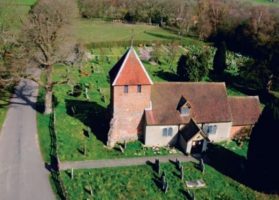Family
Tom Taylor was born on 13 January 1896 at Heath End, Tadley.
His parents were Israel Thomas and Emily Ruth Taylor (née Sandford). Israel was a ‘General Labourer’.
Tom was the second of three children and the only son: Emily, Tom and Martha.
Tom’s paternal grandparents, Israel and Patience, and his father occupied ‘Corner Cottage’ (opposite the ‘Badger’s Wood’ public house) for some years. It was while living there that Patience gives her occupation as ‘Rod Sorter’.
Like the Sandfords (see Ernest Sandford, no. 21) most of the Taylor family were also involved in the rod industry. The Taylors had a rod-stripping yard next to the war memorial in Baughurst Road.
In the 1901 Tadley Census, aged 5 years, Tom was living with his parents at Heath End. In the 1911 Tadley Census, aged 15 years, he was still living with his parents and younger sister at Heath End and his occupation was listed as ‘Hay Binder’. At the time of his death, Tom’s parents are recorded by the Commonwealth War Graves Commission as living at 1Warren Cottages, Streatley, Reading.
Tom was the nephew of Ernest Sandford whose name is also on the Tadley and Baughurst War Memorials.
Tom was unmarried.
Service record
Tom served as a private in the 1/4th Battalion of the Hampshire Regiment (service number 201728). The 1/4th Battalion, Hampshire Regiment was a unit of the Territorial Force, serving with the Hampshire Infantry Brigade, Wessex Division.
In autumn 1914 the division was ordered to India to replace British and Indian regular army units who were to be deployed to the Westem Front. In January 1915 it transferred to 4th (Rawalpindi) Brigade, 2nd (Rawalpindi) Division and in March landed at Basra with 33rd Indian Brigade and served in Mesopotamia (Iraq) and Persia (Iran) for the rest of the war. The aim of the Mesopotamian campaign was ‘protecting’ the Anglo-Persian oil pipeline, refineries and storage tanks which supplied most of the Royal Navy’s fuel.
The 1/4th Battalion suffered heavy casualties in Mesopotamia during four years of fighting – more than 31,000 officers and men from the British and Indian armies died in combat or from disease. By February 1916, the battalion had become so depleted that it was merged with the 5th Battalion, the ‘Buffs’, to form a composite Territorial Battalion which was nicknamed ‘The Huffs’. The 1/4th Battalion was reconstituted as an independent battalion in June 1916 after receiving a draft from the United Kingdom and, in November 1916, men from the other Hampshire Territorial Battalions who had been serving in India.
During February and March 1917, British and Indian forces advanced rapidly up the Tigris towards Baghdad. On 23-24 February the 1/4th Battalion were part of the push crossing the Tigris River at Shumran Bend. On 24 February, the day Tom died, the battalion had a hard day’s fighting with 450 men in action; casualties figures were 67 killed, 23 missing and 180 wounded.
Tom was initially buried in Yarbashi Prisoner of War Cemetery in ‘Asia Minor’ (Turkey). He was probably captured after being wounded and subsequently died of his wounds while a prisoner of war.
Died
Tom died of wounds on Saturday 24 February 1917, aged 21.
Commemorated
Tom is buried in Baghdad (North Gate) Cemetery [XXI T 40], Baghdad, Iraq.
The cemetery is located in a sensitive area of Baghdad. During the current political instability a two volume Roll of Honour, listing all casualties buried and commemorated in Iraq, is on view at the Commonwealth War Commission’s Head Office in Maidenhead.
Tom is remembered on both Tadley and Baughurst War Memorials.
Decorations
Tom was awarded the Victory medal and the British War medal. These would have been sent to his family.

